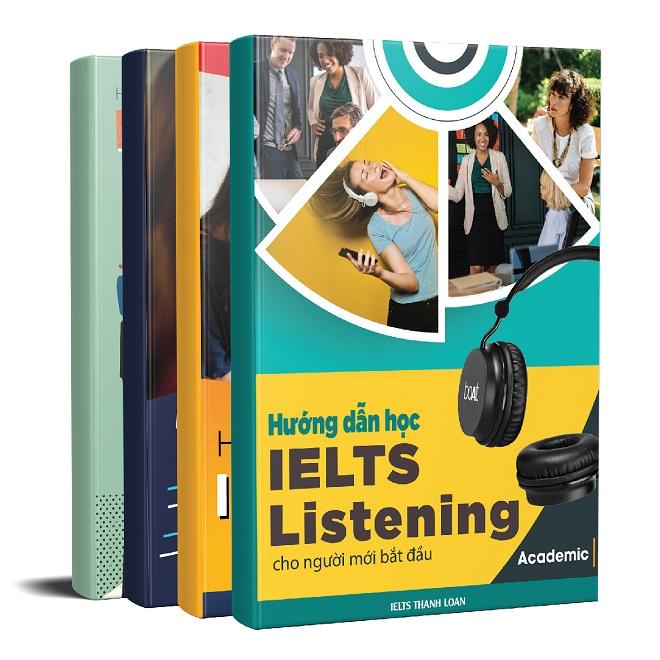Phần Listening trong IELTS thường khiến nhiều thí sinh cảm thấy nản lòng vì tốc độ bài nghe nhanh và khó bắt kịp thông tin. Tuy nhiên, thông qua bài giải chi tiết Cambridge 13 Test 2, bạn sẽ học được cách luyện nghe hiệu quả và tăng cường khả năng phản xạ khi làm bài. Bên cạnh đó, việc kết hợp ôn luyện với tài liệu luyện nghe IELTS chất lượng sẽ giúp bạn phát triển toàn diện kỹ năng, sẵn sàng chinh phục mọi dạng câu hỏi trong đề thi. Để đảm bảo rằng bạn sẽ đạt kết quả tốt nhất, hãy đăng ký học tiếng Anh online thi IELTS cùng cô Thanh Loan ngay hôm nay nhé!
Đáp án IELTS Listening Cambridge 13 Test 2
| 1. races | 11. C | 21. B | 31. location |
| 2. insurance | 12. B | 22. A | 32. world |
| 3. Jerriz | 13. C | 23. C | 33. personal |
| 4. 25/ twenty-five | 14. B | 24. C | 34. attention |
| 5. stadium | 15. B | 25. A | 35. name |
| 6. park | 16. A | 26. A | 36. network |
| 7. coffee | 17. C/E (in any order) | 27. C | 37. frequency |
| 8. leader | 18. E/C (in any order) | 28. D | 38. color/ colour |
| 9. route | 19. B/D (in any order) | 29. G | 39. brain |
| 10. lights | 20. D/B (in any order) | 30. B | 40. self |
Section 1: South City Cycling Club
1. Phân tích câu hỏi
Questions 1-10:
Complete the notes below. Write ONE WORD AND/ OR A NUMBER.
|
South city cycling club(Câu lạc bộ xe đạp South City) Example: Name of club secretary: Jim Hunter Membership
Tư cách thành viên
Training rides
Huấn luyện cưỡi ngựa
Further information
Thêm thông tin
|
2. Giải thích đáp án
JIM: Hello, South City Cycling Club.
Xin chào, câu lạc bộ xe đạp South City nghe ạ.
WOMAN: Oh, hi. Er … I want to find out about joining the club.
Ồ, xin chào … Tôi muốn tìm hiểu một số thông tin về việc tham gia vào câu lạc bộ ạ.
JIM: Right. I can help you there. I’m the club secretary and my name’s Jim Hunter (Example).
Vâng. Tôi có thể giúp bạn. Tôi là thư ký của câu lạc bộ và tên tôi là Jim Hunter.
WOMAN: Oh, hi Jim.
Ồ, chào Jim ạ.
JIM: So, are you interested in membership for yourself?
Có phải bạn muốn trở thành thành viên không?
WOMAN: That’s right.
Đúng ạ.
JIM: OK. Well there are basically two types of adult membership. If you’re pretty serious about cycling, there’s the Full membership. That costs 260 dollars and that covers you not just for ordinary cycling but also for races (Q1) both here in the city and also in other parts of Australia.
Ok. Về cơ bản có hai loại thành viên dành cho người lớn. Nếu bạn khá nghiêm túc về đạp xe, có thành viên trọn vẹn. Chi phí đó là 260 đô la và chi phí đó không chỉ cho bạn đi xe đạp thông thường mà còn cho các cuộc đua cả ở đây trong thành phố và các vùng khác của Úc.
WOMAN: Right. Well, I’m not really up to that standard. I was more interested in just joining a group to do some cycling in my free time.
Vâng. Chà, tôi không thực sự đạt tiêu chuẩn đó. Tôi thích thú hơn với việc tham gia một nhóm để đạp xe vào thời gian rảnh hơn.
JIM: Sure. That’s why most people join. So, in that case you’d be better with the Recreational membership. That’s 108 dollars if you’re over 19, and 95 dollars if you’re under.
Chắc chắn rồi. Đó là lý do tại sao hầu hết mọi người tham gia. Vì vậy, trong trường hợp đó, bạn sẽ tốt hơn với tư cách thành viên Giải trí. Nó là 108 đô la nếu bạn trên 19 tuổi và 95 đô la nếu bạn dưới tuổi.
WOMAN: I’m 25.
Tôi 25 tuổi.
JIM: OK. It’s paid quarterly, and you can upgrade it later to the Full membership if you want to, of course. Now both types of membership include the club fee of 20 dollars. They also provide insurance (Q2) in case you have an accident, though we hope you won’t need that, of course.
Ok. Nó được trả theo quývà tất nhiên bạn có thể nâng cấp nó lên thành viên Đầy đủ nếu muốn. Bây giờ cả hai loại thành viên bao gồm phí câu lạc bộ là 20 đô la. Họ cũng cung cấp bảo hiểm trong trường hợp bạn gặp tai nạn, mặc dù chúng tôi tất nhiên là hy vọng bạn sẽ không cần đến nó.
WOMAN: No. OK, well, I’ll go with the Recreational membership, I think. And that allows me to join in the club activities, and so on?
Không. Được rồi, tôi nghĩ là tôi sẽ đi với tư cách thành viên Giải trí. Và điều đó cho phép tôi tham gia các hoạt động của câu lạc bộ, v.v. chứ?
JIM: That’s right. And once you’re a member of the club, you’re also permitted to wear our kit when you’re out cycling. It’s green and white.
Đúng rồi. Và một khi bạn là thành viên của câu lạc bộ, bạn cũng được phép mặc bộ đồ của chúng tôi khi đi xe đạp. Nó màu xanh lá cây và màu trắng.
WOMAN: Yes, I’ve seen cyclists wearing it. So, can I buy that at the club?
Vâng, tôi đã thấy những người đi xe đạp mặc nó. Vậy, tôi có thể mua cái đó ở câu lạc bộ không?
JIM: No, it’s made to order by a company in Brisbane. You can find them online: they’re called Jerriz (Q3). That’s J-E-R-R-I-Z. You can use your membership number to put in an order on their website.
Không, nó được đặt hàng bởi một công ty ở Brisbane. Bạn có thể tìm thấy chúng trên mạng: chúng được gọi là Jerriz. Đó là J-E-R-R-I-Z. Bạn có thể sử dụng số thành viên của mình để đưa vào đặt hàng trên trang web của họ.
WOMAN: OK. Now, can you tell me a bit about the rides I can do?
Ok. Bây giờ, bạn có thể cho tôi biết một chút về những chuyến đi mà tôi có thể tham gia được không?
JIM: Sure. So we have training rides pretty well every morning, and they’re a really good way of improving your cycling skills as well as your general level of fitness, but they’re different levels. Level A is pretty fast – you’re looking at about 30 or 35 kilometres an hour. If you can do about 25 (Q4) kilometres an hour, you’d probably be level B, and then level C are the novices, who stay at about 15 kilometres per hour.
Chắc chắn rồi. Chúng tôi có các chuyến tập luyện khá tốt vào mỗi buổi sáng và chúng là một cách thực sự tốt để cải thiện kỹ năng đạp xe cũng như mức độ thể chất chung của bạn, nhưng chúng ở các mức độ khác nhau. Cấp độ A khá nhanh – bạn đang nhìn khoảng 30 hoặc 35 km một giờ. Nếu bạn có thể làm khoảng 25 km một giờ, bạn có thể là cấp độ B, và cấp độ C là những người mới, những người ở khoảng 15 km / giờ.
WOMAN: Right. Well I reckon I’d be level B. So, when are the sessions for that level? There are a couple each week. They’re both early morning sessions. There’s one on Tuesdays, and for that one you meet at 5.30 am, and the meeting point’s the stadium (Q5)– do you know where that is?
Vâng. Tôi nghĩtôi sẽ đạt cấp độ B. Vậy, khi nào thì có các phiên học cho cấp độ đó? Có một vài buổi mỗi tuần. Cả hai đều là buổi sáng sớm. Có một vào các ngày Thứ Ba, và một trong số đó là bạn gặp lúc 5h30 sáng và điểm hẹn là sân vận động – bạn có biết nó là đâu không?
WOMAN: Yes, it’s quite near my home, in fact. OK, and how about the other one?
Vâng, nó khá gần nhà của tôi. OK, còn cái kia thì sao?
JIM: That’s on Thursdays. It starts at the same time, but they meet at the main gate to the park (Q6).
Đó là vào các ngày Thứ Năm. Nó bắt đầu cùng một lúc, nhưng họ gặp nhau ở cổng chính về phía công viên.
WOMAN: Is that the one just past the shopping mall?
Có phải là chỉ cần qua cái trung tâm thương mại không?
JIM: That’s it.
Đúng rồi.
WOMAN: So how long are the rides?
Quãng đường đi khoảng bao xa?
JIM: They’re about an hour and a half. So, if you have a job it’s easy to fit in before you go to work. And the members often go somewhere for coffee (Q7) afterwards, so it’s quite a social event.
Chúng khoảng một tiếng rưỡi. Vì vậy, nếu bạn có việc, nó sẽ dễ dàng phù hợp trước khi đi làm. Và các thành viên thường đi đâu đó để uống cà phê sau đó, vì vậy đón như là một cuộc hẹn trò chuyện.
WOMAN: OK. That sounds good. I’ve only just moved to the city so I don’t actually know many people yet.
Ok. Nghe hay đấy. Tôi chỉ mới chuyển đến thành phố nên tôi thực sự không biết nhiều người.
JIM: Well, it’s a great way to meet people.
Ồ, thế thì đây là cách lý tưởng để bạn có thể gặp gỡ mọi người đấy.
WOMAN: And does each ride have a leader (Q8)?
Mỗi chuyến đi có người dẫn đầu không ạ?
JIM: Sometimes, but not always. But you don’t really need one; the group members onthe ride support one another, anyway.
Thỉnh thoảng thôi ạ, nhưng không phải luôn luôn. Nhưng bạn không thực sự cần một người dẫn đầu đâu; các thành viên nhóm trên dù sao đi nữa cũng hỗ trợ nhau.
WOMAN: How would we know where to go?
Làm sao chúng tôi có thể biết được là đi đâu?
JIM: If you check the club website, you’ll see that the route (Q9) for each ride is clearly.marked. So you can just print that out and take it along with you. It’s similar from one week to another, but it’s not always exactly the same.
Nếu bạn kiểm tra trang web của câu lạc bộ, bạn sẽ thấy rằng tuyến đường cho mỗi chuyến đi được đánh dấu rõ ràng. Vì vậy, bạn có thể chỉ cần in ra và mang theo bên mình. Nó tương tự từ tuần này sang tuần khác, nhưng không phải lúc nào cũng giống nhau.
WOMAN: And what do I need to bring?
Tôi cần mang theo những gì ạ?
JIM: Well, bring a bottle of water, and your phone. You shouldn’t use it while you’re cycling, but have it with you.
Hãy mang theo một chai nước và điện thoại của bạn. Bạn không nên sử dụng nó khi đang đạp xe, nhưng hãy mang theo bên mình.
WOMAN: Right.
Vâng.
JIM: And in winter, it’s well before sunrise when we set out, so you need to make sure your bike’s got lights (Q10).
Và vào mùa đông, trước khi mặt trời mọc khi chúng tôi lên đường, vì vậy bạn cần đảm bảo xe đạp của bạn có đèn.
WOMAN: That’s OK. Well, thanks Jim. I’d definitely like to join. So what’s the best way of going about it?
Vậy là được rồi. Vâng, cảm ơn Jim. Tôi chắc chắn muốn tham gia. Vậy cách tốt nhất là gì?
JIM: You can …
Mời bạn cùng tham gia cộng đồng “Học IELTS 0đ” trên Zalo cùng IELTS Online Thanh Loan, nhận những video bài giảng, tài liệu, dự đoán đề thi IELTS miễn phí và cập nhật
- quarterly (adv):
Nghĩa: produced or happening every three months
Từ vựng: a quarterly meeting of the board - upgrade (verb):
Nghĩa: to give somebody a better seat on a plane, room in a hotel, etc. than the one that they have paid for
Từ vựng: On the flight back, we were upgraded to business class. - reckon (verb):
Nghĩa: to think something or have an opinion about something
Từ vựng: I reckon (that) I’m going to get that job. - ride (noun):
Nghĩa: a short journey in a vehicle, on a bicycle, etc.
Từ vựng: Steve gave me a ride on his motorbike. - print something out/ off (phrasal verb):
Nghĩa: to produce a document or information from a computer in printed form
Từ vựng: How many copies shall I print out?
Bạn đang chuẩn bị cho kì thi IELTS?
Hãy tham khảo Khóa Học IELTS Online qua ZOOM cùng cô Thanh Loan
IELTS Thanh Loan – giáo viên 10 năm kinh nghiệm – trực tiếp đứng lớp, tự tin mang đến khóa học chất lượng nhất, phương pháp giảng dạy cô đọng dễ hiểu, giáo trình tự biên soạn cho lộ trình từ cơ bản đến luyện đề chuyên sâu. Đặc biệt, học viên luôn được quan tâm sát sao nhất, hỗ trợ không giới hạn, thúc đẩy kỷ luật học tập tốt để đạt mục tiêu.

Section 2: Information on company volunteering projects
1. Phân tích câu hỏi
Questions 11-16: Choose the correct letter A, B or C.
Information on company volunteering projects
Thông tin về các dự án tình nguyện của công ty
11. How much time for volunteering does the company allow per employee?
- A. two hours per week
- B. one day per month
- C. 8 hours per year
⇒ Công ty cho phép bao nhiêu thời gian cho hoạt động tình nguyện cho mỗi nhân viên?
A. hai giờ mỗi tuần; B. một ngày mỗi tháng; C. 8 giờ mỗi năm
Chú ý đến cụm “company allow”
12. In feedback almost all employees said that volunteering improved their
- A. chances of promotion
- B. job satisfaction
- C. relationships with colleagues
⇒ Trong các phản hồi, hầu hết tất cả nhân viên đều nói rằng hoạt động tình nguyện đã cải thiện
A. cơ hội thăng tiến; B. sự hài lòng trong công việc; C. mối quan hệ với đồng nghiệp
Chú ý đến cụm “in feedback”
13. Last year some staff helped unemployed people with their
- A. literacy skills
- B. job applications
- C. communication skills
⇒ Năm ngoái, một số nhân viên đã giúp những người thất nghiệp với
A. kỹ năng đọc viết; B. đơn xin việc; C. kỹ năng giao tiếp
Chú ý đến cụm “helped unemployed people”
14. This year the company will start a new volunteering project with a local
- A. school
- B. park
- C. charity
⇒ Năm nay, công ty sẽ bắt đầu một dự án tình nguyện mới với một
A. trường; B. công viên; C. tổ chức từ thiện
Chú ý đến cụm “this year”
15. Where will the Digital inclusion Day be held?
- A. at the company’s training facility
- B. at a college
- C. in a community centre
⇒ Ngày hội hòa nhập kỹ thuật số sẽ được tổ chức ở đâu?
A tại cơ sở đào tạo của công ty; B tại một trường cao đẳng; C trong một trung tâm cộng đồng
Chú ý đến cụm “will be held”
16. What should staff do if they want to take part in the Digital Inclusion Day?
- A. fill in a form
- B. attend a training workshop
- C. get permission from their managers
⇒ Nhân viên nên làm gì nếu họ muốn tham gia Ngày hội hòa nhập kỹ thuật số?
A. điền vào một biểu mẫu; B. tham dự một hội thảo đào tạo; C. xin phép người quản lý của họ
Chú ý đến cụm “what should staff do”
Questions 17 and 18: Choose TWO letters A-E. Which TWO things are mentioned about the participants on the last Digital Inclusion Day?
- A. they were all over 70
- B. they never used their computer
- C. their phones were mostly old fashioned
- D. they only used their phones for making calls
- E. they initially showed little interest
⇒ HAI điều nào được đề cập về những người tham gia trong Ngày hòa nhập kỹ thuật số vừa qua?
- A. họ đều trên 70
- B. họ không bao giờ sử dụng máy tính của họ
- C. điện thoại của họ chủ yếu là kiểu cũ
- D. họ chỉ sử dụng điện thoại của họ để gọi điện
- E. ban đầu họ tỏ ra ít quan tâm
Chú ý đến cụm từ “participants on the last Digital Inclusion Day”
Questions 19 and 20: Choose TWO letters A-E.
What TWO activities on the last Digital Inclusion Day did participants describe as useful?
- A. learning to use tablets
- B. communicating with family
- C. shopping online
- D. playing online games
- E. sending emails
⇒ HAI hoạt động nào trong Ngày hòa nhập kỹ thuật số vừa qua mà những người tham gia mô tả là hữu ích?
- A. học cách sử dụng máy tính bảng
- B. giao tiếp với gia đình
- C. mua sắm trực tuyến
- D. chơi trò chơi trực tuyến
- E. gửi email
Chú ý đến cụm “participants describe as useful”
2. Giải thích đáp án
Thanks for coming everyone. Okay, so this meeting is for new staff and staff who haven’t been involved with our volunteering projects yet. So basically, the idea is that we allow staff to give up some of their work time to help on various charity projects to benefit the local community. We’ve been doing this for the last five years and it’s been very successful.
Cảm ơn mọi người đã đến đây. Được rồi, vì buổi gặp mặt này dành cho nhân viên mới và những nhân viên chưa tham gia vào những dự án tình nguyện của chúng tôi. Vậy về cơ bản, ý tưởng là cho phép nhân viên dành một chút thời gian làm việc để giúp đỡ những dự án từ thiện khác nhau mang lại lợi ích cho cộng đồng ở địa phương. Chúng ta đã làm việc này trong suốt 5 năm qua và nó đã rất thành côngParticipating doesn’t necessarily involve a huge time commitment. The company will pay for eight hours of your time. That can be used over one or two days all at once, or spread over several months throughout the year (Q11). There are some staff who enjoy volunteering so much they also give up their own free time for a couple of hours every week. It’s completely up to you. Obviously, many people will have family commitments and aren’t as available as other members of staff.
Việc tham gia không nhất thiết phải đòi hỏi cam kết trong một thời gian dài. Công ty sẽ chi trả lương cho tám giờ làm việc của bạn. Điều đó có thể được sử dụng một đến hai ngày trong một lần, hoặc kéo dài một vài tháng trong suốt 1 năm. Có một vài nhân viên rất thích các công việc tình nguyện, họ cũng đồng thời dành 2 giờ mỗi tuần trong thời gian rảnh của họ. Điều đó hoàn toàn phụ thuộc vào bạn. Rõ ràng là, có rất nhiều người sẽ có những ràng buộc đối với gia đình và không sẵn sàng như những nhân viên khác.
Feedback from staff has been overwhelmingly positive. Because they felt they were doing something really useful nearly everyone agreed that volunteering made them feel more motivated at work (Q12). They also liked building relationships with the people in the local community and felt valued by them. One or two people also said it was a good thing to have on their CVs.
Phản hồi từ nhân viên là vô cùng tích cực. Bởi vì họ cảm thấy họ đang làm những việc thực sự có ích, gần như mỗi người đồng ý rằng tình nguyện khiến họ có nhiều động lực trong công việc. Họ cũng thích xây dựng mối quan hệ với mọi người trong công đồng và cảm nhận được giá trị từ chúng. Một hoặc hai người cũng nói rằng đó là một điều tốt để đưa vào CV của họ.
One particularly successful project last year was the Get Working Project. This was aimed at helping unemployed people in the area get back to work. Our staff were able to help them improve their telephone skills, such as writing down messages and speaking with confidence to potential customers, which they had found quite difficult (Q13). This is something many employers look for in job applicants – and something we all do without even thinking about, every day at work.
Một dự án thành công điển hình năm ngoái đó là Dự án Get Working. Dự án này nhằm mục đích giúp đỡ những người thất nghiệp trong khu vực có việc làm trở lại. Nhân viên của chúng ta đã có thể giúp đỡ họ cải thiện những kỹ năng sử dụng điện thoại, như là viết lời nhắn và nói chuyện tự tin với những khách hàng tiềm năng, điều mà họ đã từng nhận thấy nó khá khó khăn. Đây là điều mà rất nhiều ông chủ tìm kiếm trong những đơn xin việc làm – và những điều đó chúng ta làm mà thậm chí không cần suy nghĩ về chúng, mỗi ngày trong công việc.
Answer
| Từ vựng trong câu hỏi và đáp án | Từ vựng trong hội thoại | |
| Q11. C | 8 hours
per year |
pay for eight hours of your time
can be used over one or two days all at once, or spread over several months throughout the year |
| Q12. B | almost all employees said
volunteering improved their job satisfaction |
nearly everyone agreed
volunteering made them feel more motivated at work |
| Q13. C | staff helped unemployed people
with communication skills |
able to help them improve
their telephone skills, such as writing down messages and speaking with confidence to potential customers |
| Q14. B | start a new volunteering project with a local park | help out on a conservation project in Redfern Park |
| Q15. B | at a college | using the ICT suite at Hill College |
| Q16. A | fill in a form | complete the relevant form |
| Q17/18. C & E | their phones were mostly old fashioned | tended to be outdated models |
| initially showed little interest | most were quite dismissive at first | |
| Q19/20. B & D | communicating with family | using social media to keep in touch with their grandchildren |
| playing online games | playing online games |
3. Từ vựng
- commitment (noun):
Nghĩa: a promise to do something or to behave in a particular way
Ví dụ: I’m not ready to make a long-term commitment. - be up to somebody (idiom):
Nghĩa: to be somebody’s duty or responsibility; to be for somebody to decide
Ví dụ: It’s not up to you to tell me how to do my job. - overwhelmingly (adv):
Nghĩa: in a way that is very great or very strong; in a way that is so powerful that you cannot resist it or decide how to react
Ví dụ: They voted overwhelmingly against the proposal. - get your hands dirty (idiom):
Nghĩa: to do physical work
Ví dụ: He’s not frightened of getting his hands dirty. - keep up with something (phrasal verb):
Nghĩa: to learn about or be aware of the news, current events, etc.
Ví dụ: She likes to keep up with the latest fashions. - be paired with somebody/something (phrase):
Nghĩa: to put people or things into groups of two
Ví dụ: Each blind student was paired with a sighted student. - dismissive (adj):
Nghĩa: showing that you do not believe a person or thing to be important or worth considering
Ví dụ: She was always dismissive of other women in the office.
Tự học IELTS tại nhà chỉ từ 1.2 triệu?
Tham khảo ngay Khóa học IELTS Online dạng video bài giảng
Giải pháp tự học IELTS tại nhà, tiết kiệm chi phí, linh hoạt thời gian nhưng đảm bảo hiệu quả. Khóa học dạng video bài giảng có lộ trình học từng ngày chi tiết. Học viên học lý thuyết qua video bài giảng, thực hành Listening Reading trực tiếp trên website, còn Writing Speaking được chấm chữa trực tiếp bởi cô Thanh Loan. Mọi bài giảng đều có tài liệu học tập đi kèm.

Section 3: Planning a presentation on nanotechnology
1. Phân tích câu hỏi
Questions 21-25: Choose the correct letter A, B or C.
21. Russ says that his difficulty in planning the presentation is due to
- A. his lack of knowledge about the topic.
- B. his uncertainty about what he should try to achieve.
- C. the short time that he has for preparation.
=> Russ nói rằng khó khăn của anh ấy trong việc lập kế hoạch trình bày là do
- A. sự thiếu hiểu biết của anh ấy về chủ đề này.
- B. sự không chắc chắn của anh ta về những gì anh ta nên cố gắng đạt được.
- C. thời gian ngắn mà anh ta có để chuẩn bị.
Chú ý đến cụm từ “difficulty due to”
22. Russ and his tutor agree that his approach in the presentation will be
- A. to concentrate on how nanotechnology is used in one field.
- B. to follow the chronological development of nanotechnology.
- C. to show the range of applications of nanotechnology.
=> Russ và gia sư của anh ấy đồng ý rằng cách tiếp cận của anh ấy trong bài thuyết trình sẽ
- A. tập trung vào cách công nghệ nano được sử dụng trong một lĩnh vực.
- B. theo trình tự thời gian phát triển của công nghệ nano.
- C. để hiển thị phạm vi ứng dụng của công nghệ nano.
Chú ý đến cụm từ “his approach”
23. In connection with slides, the tutor advises Russ to
- A. talk about things that he can find slides to illustrate.
- B. look for slides to illustrate the points he makes.
- C. consider omitting slides altogether.
=> Liên quan đến các slide, gia sư khuyên Russ nên
- A. nói về những thứ mà anh ấy có thể tìm thấy các slide để minh họa.
- B. tìm các trang trình bày để minh họa những điểm anh ta đưa ra.
- C. coi như bỏ qua hoàn toàn các slide.
Chú ý đến cụm từ “connection with slides”
24. They both agree that the best way for Russ to start his presentation is
- A. to encourage the audience to talk.
- B. to explain what Russ intends to do.
- C. to provide an example.
=> Cả hai đều đồng ý rằng cách tốt nhất để Russ bắt đầu bài thuyết trình của mình là
- A. để khuyến khích khán giả nói chuyện.
- B. để giải thích những gì Russ định làm.
- C. để cung cấp một ví dụ.
Chú ý đến cụm từ “best way to start presentation”
25. What does the tutor advise Russ to do next while preparing his presentation?
- A. summarise the main point he wants to make
- B. read the notes he has already made
- C. list the topics he wants to cover
=> Gia sư khuyên Russ nên làm gì tiếp theo trong khi chuẩn bị bài thuyết trình của mình?
- A. tóm tắt điểm chính mà anh ấy muốn đưa ra
- B. đọc các ghi chú mà anh ấy đã thực hiện
- C. liệt kê các chủ đề anh ấy muốn đề cập
Chú ý đến cụm từ “tutor advise to do next”
Questions 26-30:
What comments do the speakers make about each of the following aspects of Russ’s previous presentation?
Choose FIVE answers from the box and write the correct letter A-G next to questions 26-30.
Comments
- A. lacked a conclusion
- B. useful in the future
- C. not enough
- D. sometimes distracting
- E. showed originality
- F. covered a wide range
- G. not too technical
Aspects of Russ’s previous presentation
- 26. structure
- 27. eye contact
- 28. body language
- 29. choice of words
- 30. handouts
Các diễn giả đưa ra nhận xét gì về từng khía cạnh sau đây của bài thuyết trình trước của Russ?
Chọn NĂM câu trả lời từ ô và viết đúng chữ cái A-G bên cạnh câu hỏi 26-30.
Bình luận
- A. thiếu một kết luận
- B. hữu ích trong tương lai
- C. không đủ
- D. đôi khi mất tập trung
- E. cho thấy sự độc đáo
- F. bao phủ một phạm vi rộng
- G. không quá kỹ thuật
> Mỗi phần trong bài thuyết trình trước của Russ sẽ được đưa kèm theo một nhận xét, từ A-G.
Sẽ có 2 lựa chọn không phải là đáp án cho bất cứ câu hỏi nào.
Sách luyện đề IELTS 4 kỹ năng sát thật nhất:
2. Giải thích đáp án
TUTOR: Ah … come in, Russ.
À, mời vào, Russ.
RUSS: Thank you.
Cảm ơn ạ.
TUTOR: Now you wanted to consult me about your class presentation on nanotechnology -you’re due to give it in next week, aren’t you?
Bây giờ bạn muốn hỏi ý kiến tôi về bài thuyết trình trên lớp của bạn về công nghệ nano – Bạn sẽ làm nó vào tuần tới, phải không?
RUSS: That’s right. And I’m really struggling. I chose the topic because I didn’t know muchabout it and wanted to learn more, but now I’ve read so much about it, in a way there’s too much to say – I could talk for much longer than the twenty minutes I’ve been allocated. Should I assume the other students don’t know much, and give them a kind of general introduction, or should I try and make them share my fascination with a particular aspect (Q21)?
Đúng ạ. Và em đang thực sự gặp khó khăn. Em chọn chủ đề vì em không biết nhiều về nó và muốn tìm hiểu thêm, nhưng bây giờ thì em đã đọc quá nhiều về nó, theo một cách có quá nhiều điều để nói – em có thể nói lâu hơn nhiều so với hai mươi phút mà em đã được phân bổ. Em có nên cho rằng các sinh viên khác không biết nhiều và giới thiệu chung cho họ, hay em nên cố gắng làm cho họ chia sẻ niềm đam mê của em với một khía cạnh cụ thể?
TUTOR: You could do either, but you’ll need to have it clear in your own mind.
Bạn có thể làm một trong hai, nhưng bạn cần phải hiểu rõ điều đó trong tâm trí của mình.
RUSS: Then I think I’ll give an overview.
Sau đó em nghĩ em sẽ cần một bản sơ lược.
TUTOR: OK. Now, one way of approaching this is to work through developments in chronological order.
Ok. Bây giờ, một cách để tiếp cận điều này là làm việc thông qua các phát triển trong thứ tự thời gian.
RUSS: Uh-huh.
Vâng.
TUTOR: On the other hand, you could talk about the numerous ways that nanotechnology is being applied
Mặt khác, bạn có thể nói về nhiều cách mà công nghệ nano đang được áp dụng.
RUSS: You mean things like thin films on camera displays to make them water-repellent,and additives to make motorcycle helmets stronger and lighter.
Ý bạn là những thứ như màng mỏng trên màn hình máy ảnh để làm cho chúng không thấm nước, và các chất phụ gia để làm cho mũ bảo hiểm xe máy bền và nhẹ hơn ạ.
TUTOR: Exactly. Or another way would be to focus on its impact in one particular area, say (Q22) medicine, or space exploration.
Chính xác. Hoặc một cách khác là tập trung vào tác động của nó trong một lĩnh vực cụ thể, chẳng hạn như y học, hoặc khám phá không gian.
RUSS: That would make it easier to focus. Perhaps I should do that.
Điều đó sẽ giúp em dễ dàng tập trung hơn. Có lẽ em nên làm điều đó.
TUTOR: I think that would be a good idea.
Tôi nghĩ đó là ý tưởng hay đấy.
RUSS: Right. How important is it to include slides in the presentation?
Vâng. Tầm quan trọng của việc đưa các slide vào bài thuyết trình như thế nào ạ?
TUTOR: They aren’t essential, by any means. And there’s a danger of tailoring what you sayto fit whatever slides you can find. While it can be good to include slides, you could (Q23) end up spending too long looking for suitable ones. You might find it better to leave them out.
Chúng không cần thiết, bởi bất kỳ phương tiện nào. Và có nguy cơ sửa đổi những gì bạn nói để phù hợp với bất kỳ trang trình bày nào bạn có thể tìm thấy. Mặc dù có thể tốt khi bao gồm các trang trình bày, nhưng cuối cùng bạn có thể dành quá nhiều thời gian để tìm kiếm những trang trình bày phù hợp. Bạn có thể thấy tốt hơn nếu bỏ chúng đi.
RUSS: I see. Another thing I was wondering about was how to start. I know presentations often begin with ‘First I’m going to talk about this, and then I’ll talk about that’, but I thought about asking the audience what they know about nanotechnology.
Em hiểu rồi ạ. Một điều nữa mà em băn khoăn là làm thế nào để bắt đầu. Em biết thuyết trình thường bắt đầu bằng ‘Đầu tiên tôi sẽ nói về điều này, sau đó tôi sẽ nói về điều đó’, nhưng em đã nghĩ đến việc hỏi khán giả họ biết gì về công nghệ nano.
TUTOR: That would be fine if you had an hour or two for the presentation, but you might find that you can’t do anything with the answers you get, and it simply eats into the short time that’s available.
Điều đó tốt nếu bạn có một hoặc hai giờ cho bài thuyết trình, nhưng bạn có thể thấy rằng bạn không thể làm bất cứ điều gì với câu trả lời bạn nhận được, và nó chỉ ngốn thời gian ngắn mà bạn được phép thôi.
RUSS: So, maybe I should mention a particular way that nanotechnology is used, to focus (Q24) people’s attention.
Thế thì có lẽ em nên đề cập đến một cách cụ thể mà công nghệ nano được sử dụng, để tập trung vào sự chú ý của mọi người.
TUTOR: That sounds sensible.
Nghe có vẻ hay đấy.
RUSS: What do you think I should do next? I really have to plan the presentation today and tomorrow.
Thế em nên làm gì tiếp theo? Em thực sự phải lên kế hoạch cho buổi thuyết trình hôm nay và ngày mai.
TUTOR: Well, initially I think you should ignore all the notes you’ve made, take a small piece of paper, and write a single short sentence that ties together the whole presentation: (Q25) it can be something as simple as ‘Nanotechnology is already improving our lives’. Then start planning the content around that. You can always modify that sentence, if you need to.
Chà, ban đầu tôi nghĩ bạn nên bỏ qua tất cả những ghi chú bạn đã ghi, hãy lấy một mẩu nhỏtrên giấy, và viết một câu ngắn duy nhất gắn kết toàn bộ bài thuyết trình với nhau: nó có thể là một cái gì đó đơn giản như ‘Công nghệ nano đã và đang cải thiện cuộc sống của chúng ta’. Sau đó, bắt đầu lập kế hoạch nội dung xung quanh đó. Bạn luôn có thể sửa đổi câu đó sau, nếu cần.
RUSS: OK
Ok.
TUTOR: OK, now let’s think about actually giving the presentation. You’ve only given one before, if I remember correctly, about an experiment you’d been involved in.
OK, bây giờ chúng ta hãy nghĩ về việc thực sự thuyết trình. Bạn chỉ đưa ra một trước đây, nếu tôi nhớ không lầm, về một thử nghiệm bạn đã tham gia.
RUSS: That’s right. It was pretty rubbish!
Dạ vâng, nó khá tệ.
TUTOR: Let’s say it was better in some respects than in others. With regard to the structure. I (Q26) felt that you ended rather abruptly, without rounding it off. Be careful not to do that in next week’s presentation.
Giả sử nó tốt hơn ở một số khía cạnh so với những khía cạnh khác. Đối với cấu trúc. Tôi cảm thấy rằng bạn đã kết thúc khá đột ngột, mà không tổng kết nó. Hãy cẩn thận đừng làm điều đó trong bài thuyết trình tuần tới.
RUSS: OK
Vâng.
TUTOR: And you made very little eye contact with the audience, because you were looking (Q27) down at your notes most of the time. You need to be looking at the audience and only occasionally glancing at your notes.
Và bạn rất ít giao tiếp bằng mắt với khán giả, vì bạn đang nhìn hầu hết thời gian ghi chú của bạn. Bạn cần phải nhìn vào khán giả và chỉ thỉnh thoảng liếc nhìn ghi chú của bạn.
RUSS: Mmm.
Mmm.
TUTOR: Your body language was a little odd. Every time you showed a slide, you turned your (Q28) back on the audience so you could look at it – you should have been looking at your laptop. And you kept scratching your head, so I found myself wondering when youwere next going to do that, instead of listening to what you were saying!
Ngôn ngữ cơ thể của bạn hơi kỳ quặc. Mỗi khi bạn trình chiếu một slide, bạn lại quay của mình về phía khán giả để bạn có thể nhìn vào nó – lẽ ra bạn nên nhìn vào máy tính xách tay của mình. Và bạn cứ vò đầu bứt tai, vì vậy tôi thấy mình tự hỏi khi bạntiếp theo sẽ làm điều đó, thay vì lắng nghe những gì bạn đang nói!
RUSS: Oh dear. What did you think of the language? I knew that not everyone was familiar with the subject, so I tried to make it as simple as I could.
Ôi trời. Thầy đã nghĩ gì về ngôn ngữ này? Em biết rằng không phải ai cũng quen với chủ đề, vì vậy em đã cố gắng làm cho nó đơn giản nhất có thể.
TUTOR: Yes, that came across. You used a few words that are specific to the field, but you (Q29) always explained what they meant, so the audience wouldn’t have had any difficulty understanding.
Vâng, điều đó đã xảy ra. Bạn đã sử dụng một vài từ cụ thể cho lĩnh vực này, nhưng bạn luôn giải thích ý nó nghĩa là gì để khán giả không gặp khó khăn để hiểu.
RUSS: Uh-huh.
Vâng.
TUTOR: I must say the handouts you prepared were well thought out. They were a good summary of your presentation, which people would be able to refer to later on(Q30). So well done on that.
Tôi phải nói rằng các tài liệu bạn chuẩn bị đã được chu đáo. Chúng là một bản tóm tắt hay về bài thuyết trình của bạn, mà mọi người sẽ có thể tham khảo sau này. Vì vậy, thực hiện tốt về điều đó.
RUSS: Thank you.
Em cảm ơn.
TUTOR: Well, I hope that helps you with next week’s presentation.
Tôi hy vọng có thể giúp bạn với bài thuyết trình tuần tới.
RUSS: Yes, it will. Thanks a lot.
Vâng, Em cảm ơn nhiều ạ.
TUTOR: I’ll look forward to seeing a big improvement, then.
Tôi hy vọng sẽ nhìn thấy được sự tiến bộ rõ rệt của bạn.
Answer
| Từ vựng trong câu hỏi và đáp án | Từ vựng trong hội thoại | |
| Q21. B | his uncertainty about what he should try to achieve | Should I assume …. or should I try … |
| Q22. A | concentrate on how nanotechnology is used in one field | focus on its impact in one particular area |
| Q23. C | look for slides to illustrate the points he makes | good to include slides, you could end up spending too long looking for suitable ones |
| Q24. C | to provide an example | a particular way that nanotechnology is used |
| Q25. A | summarise the main point he wants to make | write a single short sentence that ties together the whole presentation |
| Q26. A | lacked a conclusion | ended rather abruptly, without rounding it off |
| Q27. C | not enough | very little eye contact with the audience |
| Q28. D | sometimes distracting | back on the audience so you could look at it – you should have been looking at your laptop |
| Q29. G | not too technical | wouldn’t have had any difficulty understanding |
| Q30. B | useful in the future | able to refer to later on |
3. Từ vựng
- Allocate (verb):
Nghĩa: to give something officially to somebody/something for a particular purpose
Ví dụ: A large sum has been allocated for buying new books for the library. - Chronological (adj):
Nghĩa: (of a number of events) arranged in the order in which they happened
Ví dụ: The facts should be presented in chronological order. - Modify something (verb):
Nghĩa: to change something slightly, especially in order to make it more suitable for a particular purpose
Ví dụ: Patients are taught how to modify their diet. - Abruptly (adv):
Nghĩa: in a sudden, unexpected and often unpleasant way
Ví dụ: The interview ended abruptly. - Round something off (phrasal verb):
Nghĩa: to finish an activity or complete something in a good or suitable way
Ví dụ: She rounded off the tour with a concert at Carnegie Hall.
Section 4
1. Phân tích câu hỏi
Questions 31-40:
Complete the notes below. Write ONE WORD ONLY for each answer.
|
Episodic memory (Trí nhớ phân đoạn)
Forming episodic memories involves three steps: Encoding
Consolidation
Retrieval
Episodic memory impairments
|
2. Giải thích đáp án
Today, we’ll be continuing the series of lectures on memory by focusing on what is called episodic memory and what can happen if this is not working properly.
Hôm nay, chúng ta sẽ tiếp tục loạt bài giảng về trí nhớ bằng cách tập trung vào thứ được gọi là trí nhớ theo từng giai đoạn và điều gì có thể xảy ra nếu điều này không hoạt động đúng cách.Episodic memory refers to the memory of an event or ‘episode’.
Episodic memories allow us to mentally travel back in time to an event from the past. Episodic memories include various details about these events, for example, when an event happened and other information such as the location (Q31). To help understand this concept, try to remember the last time you ate dinner at a restaurant. The ability to remember where you ate, who you were with and the items you ordered are all features of an episodic memory.
Bộ nhớ theo giai đoạn đề cập đến bộ nhớ của một sự kiện hoặc ‘tập phim’. Ký ức giai đoạn cho phép chúng ta du hành ngược thời gian về một sự kiện trong quá khứ. Ký ức giai đoạn bao gồm các chi tiết khác nhau về những sự kiện này, ví dụ, khi một sự kiện xảy ra và các thông tin khác như vị trí. Để giúp hiểu khái niệm này, hãy cố gắng nhớ lại lần cuối cùng bạn ăn tối tại nhà hàng. Khả năng nhớ nơi bạn đã ăn, bạn đã ở cùng với ai và các món bạn đã gọi là tất cả các đặc điểm của ký ức nhiều tập.
Episodic memory is distinct from another type of memory called semantic memory. This is the type of factual memory that we have in common with everyone else – that is your general knowledge of the world (Q32). To build upon a previous example, remembering where you parked your car is an example of episodic memory, but your understanding of what a car is and how an engine works are examples of semantic memory. Unlike episodic memory, semantic memory isn’t dependent on recalling personal (Q33) experiences.
Bộ nhớ theo giai đoạn khác biệt với một loại bộ nhớ khác được gọi là bộ nhớ ngữ nghĩa. Đây là loại trí nhớ thực tế mà chúng ta có chung với những người khác – đó là kiến thức chung của bạn về thế giới. Để xây dựng dựa trên ví dụ trước, việc nhớ nơi bạn đã đỗ xe là một ví dụ về trí nhớ theo từng giai đoạn, nhưng sự hiểu biết của bạn về ô tô là gì và cách động cơ hoạt động là ví dụ về trí nhớ ngữ nghĩa. Không giống như ký ức từng đoạn, trí nhớ ngữ nghĩa không phụ thuộc vào việc nhớ lại những trải nghiệm cá nhân.
Answer
| Từ vựng trong câu hỏi và đáp án | Từ vựng trong hội thoại | |
| Q31. location | ability to recall details e.g. the time and location of past events | include various details about these events, for example, when an event happened and other information such as the location |
| Q32. world | Different to semantic memory- the ability to remember general information about the world | the type of factual memory that we have in common with everyone else – that is your general knowledge of the world |
| Q33. personal | not involve recalling personal information | isn’t dependent on recalling personal experiences |
| Q34. attention | The more attention given to an event the more successfully it can be encoded | successfully encode information depends on the level of attention you give to an event while it’s actually happening |
| Q35. name | remember a name
it is useful to have a strategy for encoding such information |
introduced to someone called Charlie
you might make the connection that your uncle has the same name |
| Q36. network | Most effective when memories can be added to a network | most effective when the information being stored can be linked to an existing network of information |
| Q37. frequency | Frequency of retrieval affects the strength of memories | Forming strong memories depends on frequency with which you try to retrieve them |
| Q38. color | Memory retrieval often depends on using a prompt
e.g. the color of an object near to the place where you left your car |
episodic memory retrieval by acting as a prompt
For example, when recalling where you parked your car you may use the colour of a sign close to where you parked |
| Q39. brain | Games which stimulate the brain | games designed to keep the brain active can help improve their episodic memory |
| Q40. self | Children with autism may have difficulty forming episodic memories possibly because their concept of the self may be absent | something individuals with autism often have problems with. This may be caused by an absence of a sense of self |
3. Từ vựng
- Recall something (verb):
Nghĩa: to remember something
Ví dụ: She could not recall his name. - Facilitate something (verb):
Nghĩa: to make an action or a process possible or easier
Ví dụ: The new trade agreement should facilitate more rapid economic growth. - Recollection (of doing something) (uncountable noun):
Nghĩa: the ability to remember something; the act of remembering something
Ví dụ: I have no recollection of meeting her before - Impairment (uncountable noun):
Nghĩa: the state of having a physical or mental condition that means that part of your body or brain does not work correctly;
Ví dụ: impairment of the functions of the kidney. - Intimate (adj):
Nghĩa: private and personal
Ví dụ: The article revealed intimate details about his family life.
Sách học IELTS cho người mới bắt đầu nào tốt?
Combo 4 cuốn Hướng dẫn tự học IELTS dành riêng cho người Việt
- Listening & Reading: Tiếp cận IELTS theo từng dạng câu hỏi, chia sẻ chiến thuật làm bài, mẹo hay cho từng dạng, và bài tập thực hành theo dạng.
- Writing: Hướng dẫn chi tiết cách viết câu – đoạn – bài văn và nhiều templates phong phú, rất dễ áp dụng
- Speaking: Cấu trúc câu trả lời tốt cho Speaking Part 1-2-3 kèm từ vựng phổ biến
Chắc chắn đây là bộ sách cực dễ đọc và dễ áp dụng cho sĩ tử IELTS Việt Nam.














